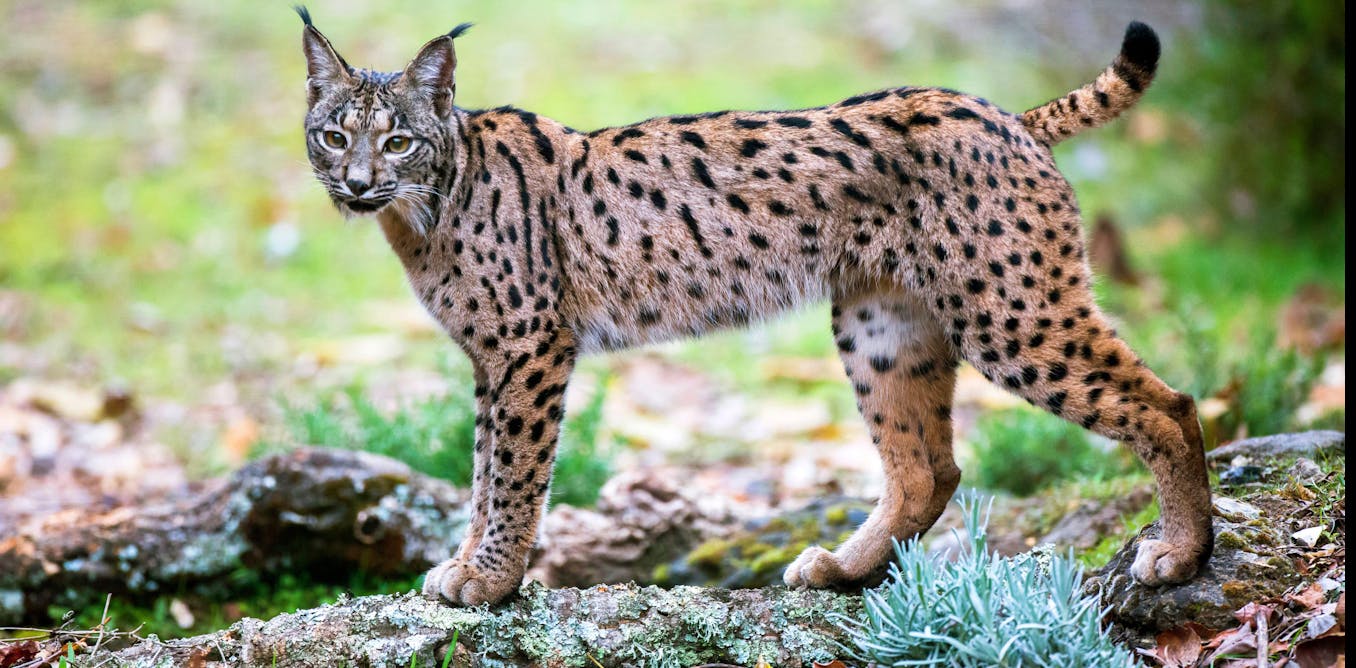Ancient DNA helped us uncover the Iberian lynx’s potential secret weapon against extinction

مجلة المذنب نت متابعات عالمية:
Many large mammals have lost genetic diversity, often thanks to the actions of people shrinking their populations. The implications can be severe because without genetic diversity, a population does not have a “genetic database” to fall back on to adapt to environmental change.
The Iberian lynx (Lynx pardinus) is no stranger to this reduction in diversity. Human activity has driven populations to dangerously low numbers, leaving them with a shrinking genetic pool. This loss threatens the lynx’s ability to adapt to changing environments, putting their survival at risk.
Our team’s research reveals how the Iberian lynx interbred with its cousin, the Eurasian lynx (Lynx lynx) over the past few thousand years. This mingling may have boosted the Iberian lynx’s genetic diversity. This is a crucial factor for its survival, especially as the species faces such an uncertain future.
Low genetic diversity can lead to “inbreeding depression”, where closely related animals breed and produce offspring that are less fit for survival. In extreme cases, this can push entire populations, or even species, to the brink of extinction.
To boost the genetic diversity of populations on the brink, conservationists sometimes turn to “genetic rescue”. This involves introducing individuals from different populations in the hope that they will breed with the local animals, reducing inbreeding and enhancing genetic diversity.
While this strategy can be effective, it’s not without risks. Introducing animals that are too genetically different can disrupt or dilute beneficial traits, potentially harming the population’s ability to survive and reproduce. It’s a phenomenon known as “outbreeding depression”. Despite these risks, genetic rescue remains a valuable tool in conservation, though it’s often approached with caution.
One of the most severe cases of reduced genetic diversity is the Iberian lynx, once the world’s most threatened cat species. It’s mostly found in parts of Spain and Portugal.
Rescue and recovery
Today, the Iberian lynx is recovering from near extinction. More than 400 reproductive females were reported in the 2023 census. This is a massive increase from just 25 in 2002. This turnaround is largely thanks to an ambitious conservation programme over the past two decades, involving coordinated breeding programmes and reintroductions.
Part of this success is due to the “genetic rescue” effect, where mixing the two remaining genetically distinct populations helped boost the species’ genetic diversity. Despite this progress, the Iberian lynx still faces significant challenges. The population is far from reaching the minimum of 1,100 reproductive females needed to be considered genetically viable. So, its genetic diversity remains one of the lowest ever recorded.
Further genetic rescue could be a solution to enhance diversity. But there’s a catch – no other Iberian lynx populations exist in the world that could serve as a source of new genetic material.
Jaroslav Macenauer/Shutterstock
Ancient DNA can be extracted from historical remains or subfossil (animals that are not ancient enough to be considered true fossils but are not considered modern either) samples. By studying these, scientists can gain valuable insights into the genetic past of species, offering a stark comparison with their present day counterparts.
In 2015, our colleague Maria Lucena-Perez first visited the lab of another of our colleagues, Michael Hofreiter, in Germany to generate the very first whole genome data from ancient Iberian lynx bones. Extracting ancient DNA from bones is a highly specialised process that requires dedicated cleanroom facilities to prevent contamination from modern DNA.
Working together, our team successfully extracted nuclear DNA from three ancient Iberian lynx specimens. Two of these were approximately 2,500 years old. The third dated back more than 4,000 years. This marked the first time nuclear DNA had ever been retrieved from ancient Iberian lynx. Maria’s achievement has significantly advanced our understanding of how the genetic makeup of the Iberian lynx has evolved over thousands of years.
Our team analysed and compared the DNA with that of modern Iberian lynx. To our surprise, the ancient lynx showed even lower genetic diversity than their modern descendants. Given the sharp decline in their populations over the past few centuries, this finding was both unexpected and puzzling.

Karla Fritze, University of Potsdam, Author provided (no reuse)
Species interbreeding
The missing piece of the puzzle came with the discovery that modern Iberian lynx populations share more genetic variants with the closely related Eurasian lynx than their ancient counterparts did. This suggests that the two species successfully interbred within the past 2,500 years, boosting the genetic diversity of today’s Iberian lynx.
These findings align with extensive genomic evidence of ancient gene flow from Eurasian lynx into the Iberian lynx genome. While the two species don’t share the same habitats today, they once coexisted in the Iberian Peninsula, and possibly in southern France and northern Italy. This situation would have provided plenty of opportunities for interbreeding.
The potential for these two species to naturally meet and breed is growing once more as their ranges continue to expand. This could open up new possibilities for genetic diversity in the future.
The advent of whole nuclear genome analysis over the past 30 years has revealed numerous cases of cross-species interbreeding, such as between polar bears and brown bears. This suggests that the case of the lynx is not so unusual. But the Iberian lynx stands out as the first documented example where interspecies breeding significantly increased species-wide genetic diversity.
We still don’t fully understand the exact effect of this genetic boost, particularly whether it improved the population’s fitness and survival. One intriguing possibility is that the Iberian lynx has managed to persist despite its extremely low genetic diversity, thanks to recurrent genetic rescues by the Eurasian lynx.
While there’s more to learn, our research offers an unexpected but important case study for the broader discussion on genetic rescue. If we can better predict the chances of inbreeding and outbreeding depression when interbreeding happens, we could use genetic rescue more effectively as a conservation tool in the ongoing biodiversity crisis.
نشكركم على قراءة المنشور عبر مجلة المذنب نت, المتخصصة في التداول والعملات الرقمية والمشفرة















